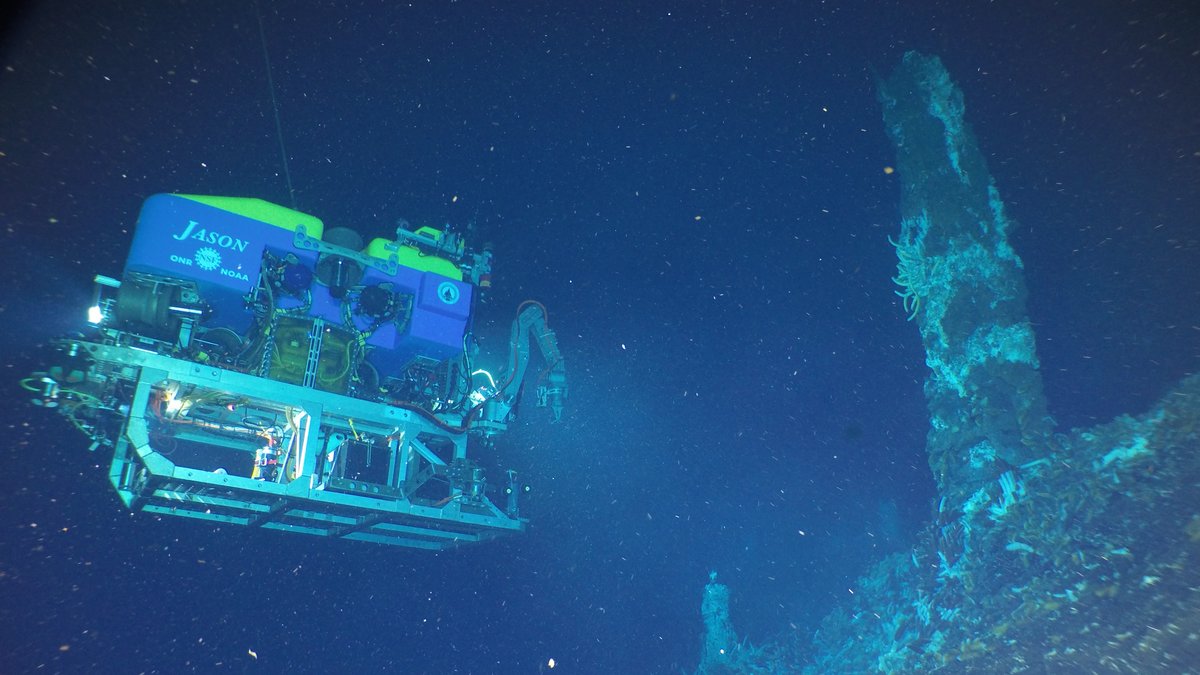
Dr. Rose Jones is an ocean scientist in Minnesota, “which is a very logical place to be,” she says with a bit of a laugh. Her interest in microbes that live in extreme environments and survive without sunlight led to her postdoc position Prof. Brandy Toner’s lab in the Department of Soil, Water, and Climate. The lab studies the geochemistry of low temperature environments, including the seafloor.
While nearly every food chain on the planet starts with the energy from the sun being captured by photosynthesis, on the seafloor there are ecosystems that live in total darkness. The first link in these food chains is the chemical energy provided by hot fluids escaping from the spreading tectonic plates. Specialized microbes have the ability to harness energy directly from the rocks. The crabs, worms, and other unusual sea creatures that live near hydrothermal vents all depend on these microbes and their ability to convert the rock energy into biological energy. “There’s an awful lot of life down there, all relying on these very small creatures,” says Jones.
To learn exactly how microbes obtain energy from the rocks, Jones’ needs to collect rock samples from the seafloor that she can analyze back in the lab. That was her objective during a month-long research expedition to the middle of the Pacific ocean earlier this year.
Pandemic Preparations
In March 2021, Jones was in quarantine. To ensure a safe experience in the midst of the pandemic, the entire research and technical crew of the research vessel Roger Revelle quarantined for two weeks and were tested for COVID-19 twice before boarding the ship in San Diego.
The ship is a floating laboratory, and researchers must pack everything they might need at sea. Usually they’re able to load up and grab a few things at the last minute, but due to the COVID precautions, they only had one chance to outfit the lab, down to paper towels, rubber gloves, and spatulas.
The ship spent seven days navigating through the Pacific before they arrived at their destination: a particular spot along the East Pacific Rise, the tectonic plate boundary that runs along the seafloor. The diverging tectonic plates release hot, chemically-rich fluid creating the hydrothermal vents Jones came here to study.
Everyday is Tuesday
Once the ship was on station, or directly over the sampling site, the round the clock work began. Jones recalls “It’s a full on day, and it’s on ship… You don't have weekends and you don't have going home in the evening. We have a saying: every day it's a Tuesday.”
The team used a remotely operated vehicle (ROV) called Jason to explore their underwater surroundings. From a control room on the ship, Jason is able to navigate to specific locations, collect rock samples using its robotic arms, take photographs and even live-stream on YouTube.
A typical day for Jones included a “Jason shift” from midnight to 4 AM and noon to 4 PM. As the science lead for the shift, she was responsible for informing the pilots of the science objectives the team wanted the ROV to complete: picking up samples, measuring hydrothermal fluid temperature, and just making observations and recording data, because so much is still being discovered on every expedition.
Hot to Cold
Hydrothermal vents were discovered about 40 years ago, and scientists are still asking questions about the complex and alien ecosystems they support. An experiment Jones is involved in, called Hot2Cold Vents, asks what happens when the heat stops?
Because the tectonic plates are constantly moving, a mound will eventually move off of its geothermal energy source. At the rate of a few inches per year, this can take anywhere from decades to thousands of years. What will happen to the microbes and the rest of the ecosystem when the vent fluids are no longer supplying the rocks with chemical energy?
In 2019, on a previous research cruise, Jones and her collaborators set this process in motion on a faster timescale, by removing rock samples from an active hot vent and letting them cool. They brought some samples to the surface to analyze, and left some rocks on the seafloor to cool gradually. This cruise was an opportunity to go back and collect those rocks, which have been detached from the vent for two years.
While exploring with ROV Jason, Jones was fortunate enough to discover some naturally deceased vents as well. These “old, dead sites,” can shed light on the changes that active vents will eventually undergo.
Back on Land
Her sea-floor samples back on land, Jones is spending the summer preparing those samples to be run on a synchrotron, an instrument that uses x-rays to characterize the mineral composition of the rocks she’s collected.
“We can use these x-ray techniques to get a microbe’s-eye view of the world.” Because the sea floor microbes harness energy from the rocks, they leave behind chemical signatures of their presence. Those minute changes can be detected by the synchrotron.
Jones now has rock samples from active hydrothermal vents, her two year old cooled samples, and the naturally inactive sites she discovered. By looking at this array of rocks, she’ll begin to understand the progression of these microbes through the chemical changes preserved in rock.
